The end of the world has been prophesized in many different ways for thousands of years. Some say it will involve meteors and tidal waves, or catastrophic earthquakes that will rip the world apart. In World’s End Club, you get to experience one version of how the Earth might meet its end through the eyes of a group of schoolchildren. How did the world end up this way? The Go-Getters Club hopes to find that out.
STORY
A bus of elementary school-aged children (the self-styled Go-Getters Club) is on its way to a school field trip when a meteor strikes their town and they are blown off the road. When they awaken, they find themselves in an underwater theme park. A strange creature informs them that they must play a game to survive. Even after escaping this tense situation, the group finds that the world they remember isn’t any more normal. With many questions on their mind, they decide to travel back to their hometown of Tokyo to see if they can find some answers.
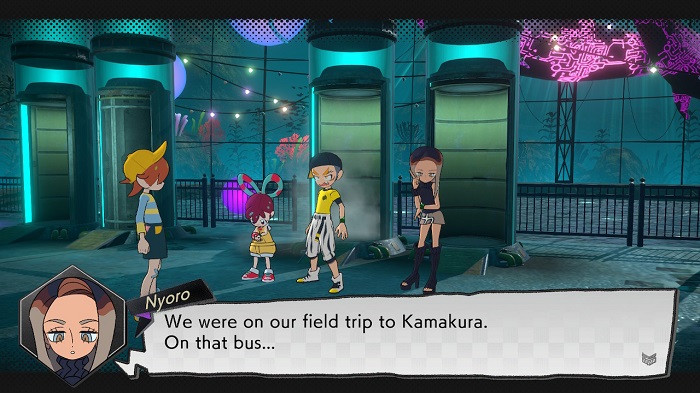
The story of World’s End Club is told through various story scenes as you play, either via dedicated story stages or smaller scenes in platforming or camp stages. You may come into this game expecting it to be like the Danganronpa or Zero Escape series, based on the demo or the fact that key developers from both games worked on this one. However, other than many similarities to those titles in the early game, World’s End Club is a different type of game with a plot that is much more light-hearted. The characters are notably younger, and there is much more room for jokes and positivity here than what you’d find in those developers’ previous games, even with a few instances of more serious themes. Many of the common character tropes seen in manga and anime are represented in the characters, such as the classic “tsundere” (mean but also sweet) and jock personality types. The plot also unfolds in an unconventional manner by way of branching gameplay, which is a neat feature for a puzzle platformer such as this, no doubt inspired by the developer’s previous work in the visual novel genre.
GAMEPLAY
The core gameplay in World’s End Club involves platforming from left to right, the standard format for any platformer. Certain platforming stages also feature stealth and chase sequences, which is great for a bit of variety. You control different members of the Go-Getters Club throughout the game, using their unique abilities to get past enemies or obstacles in the environment. However, during story scenes, you are put into the perspective of Reycho, the stereotypical silent protagonist that the rest of the members depend on to stoically lead the group on their journey across Japan. There is a choice in difficulty at the start of the game (Normal or Easy) that also affects how difficult the gameplay is and how much health bosses have, but the entire game can be completed on Normal with very little effort for those used to platformers. Those looking for something more challenging might be disappointed by the lack of difficulty, but it doesn’t diminish the quality of the story.
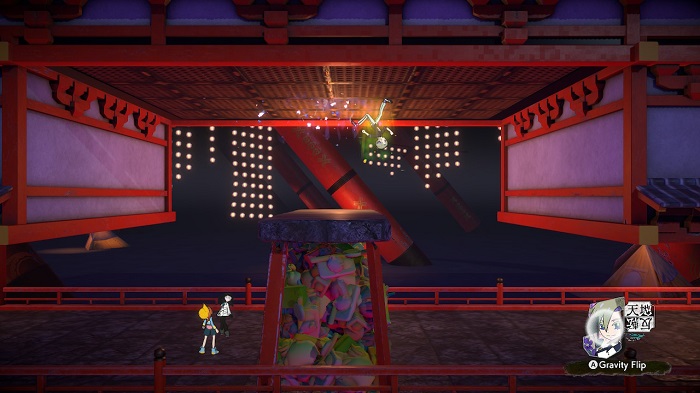
Stages
World’s End Club is a game played stage by stage, which sounds like any other game, but in this case it’s quite literally a sequence of different types of stages. Some are story-themed, so the entire segment is made up of lots of dialogue between characters. These are always great because they expand on the game’s strong point: its plot. The stages that involved player interaction are the “act” stages, which are where your platforming skills are needed. These stages only allow you to control one character at a time, showcasing that particular character’s unique ability, such as Reycho’s skill that allows him to throw objects at enemies. While this gives the game’s otherwise simple platforming stages a bit of variety, it would have been better to allow the player to switch between characters manually to use their abilities as needed. Another thing to note is that you only have one life, so any hit or fall off a ledge will get you a “game over”. However, you can die like this an infinite amount of times, and dying just sets you back at the latest checkpoint which is usually not too far back.
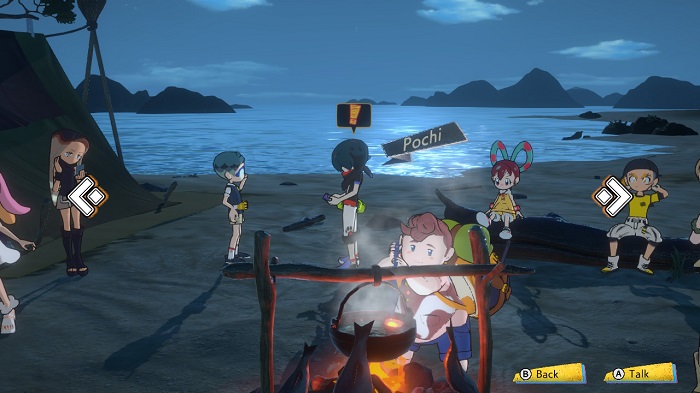
Occasionally there are camp levels, which allow you to talk to each Go-Getters Club member. Like story stages, these help to develop every character, though some get much more development than others. The little interactions between Reycho and his friends are often quite cute, especially when multiple characters interact with each other as well. The music and atmosphere of these stages really put you at ease between some of the more serious story and act stages.
Decisions
At several points in World’s End Club, the members of the Go-Getters Club will be split on the route they take on their trip back to Tokyo. In these cases, Reycho must act as the tie-breaker, which in turn determines where you proceed as well. This creates branches in the gameplay and story, taking you to different parts of Japan that feature their own stages. Once a decision has been made, you are unable to go back and change your choice, as the game has an autosave system that doesn’t allow manual saves. This is a surprising design choice given the common practice of making multiple saves in visual novels, which are the types of games where you often see this kind of branching story. However, World’s End Club does not feature near the same amount of routes or endings as a visual novel, so this isn’t as big a deal as it may seem.
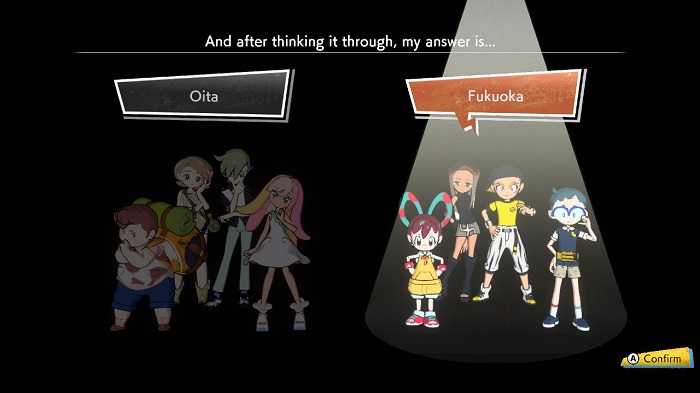
Stage Map
Between playing each stage, you can view a map of your progress across Japan toward your destination of Tokyo. Various landmarks are depicted all over the country. You can also see a simple stage flowchart under the map, displaying the levels you’ve completed and their type (story, act, or camp). You can also see a line connecting these stages, representing the flow of the story and how your decisions have affected it. You’re able to go back and replay each stage to collect any stickers or to make a different decision, but only after a certain point in the story. Overall, the map is a great way to visualize the Go-Getters Club’s progress and their past exploits.
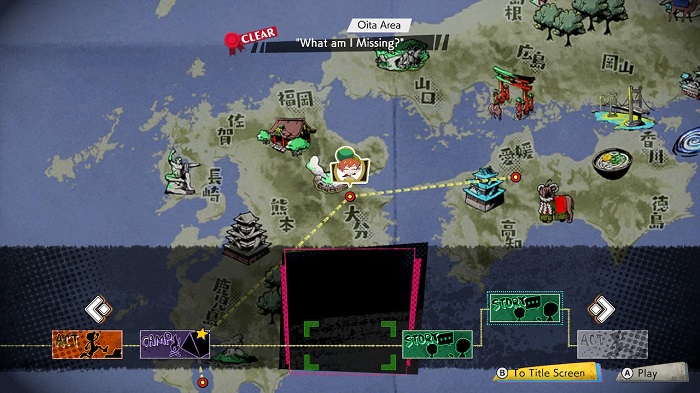
Bosses
In some platforming stages, the level will culminate in a boss battle. These enemies are bigger and much smarter than the simple enemies you usually encounter. They also sport their own health bar, so you know you’ve got a battle ahead of you. These bosses offer a tiny bit of challenge compared to what you’re used to, but even though you might die a few times on each boss, it won’t take long to vanquish them. At the same time, because of World End Club‘s system of one-hit deaths, some bosses can be tougher than others, as a death will set you back further. There are often checkpoints throughout the fight to mitigate this issue, but this isn’t always the case. Even so, there are no bosses that pose much of a challenge.
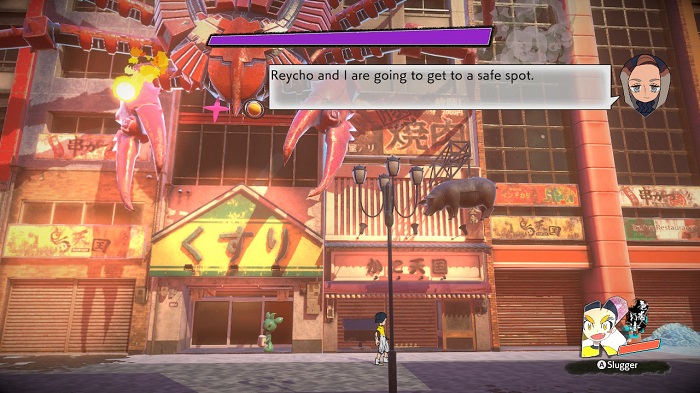
ART
World’s End Club makes a strong impression just by looking at the cover art or promotional images. Everything from the characters to the environments is depicted in a large palette of colors. Even the menus have a splash of style and color. The characters each have their own distinct style, from the stylish Nyoro to the mousy Chuko. Eagle-eyed players may notice that the characters have a familiar look to them. This is because the character designer, Takegarou, also did the character designs for Pokemon Sun and Moon. The character animations are great too, with every emotion being evident in how the characters move during story scenes. It’s also nice to see different depictions of Japan, as every stage features scenery that is relatively faithful to that region. The illustrated shots that are used during certain scenes in the game are nice to look at too. These can be viewed at any time from the main menu after you’ve seen them in your playthrough.
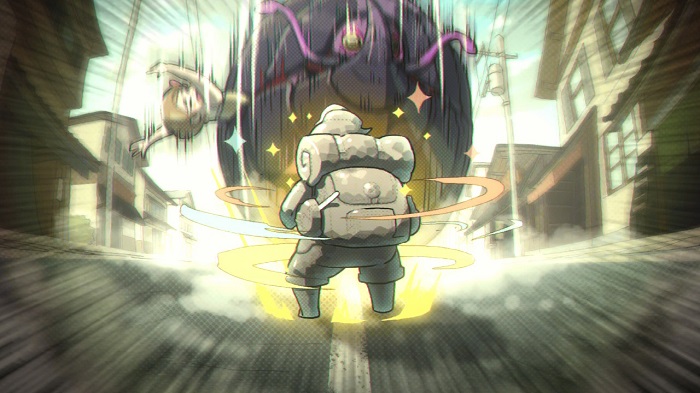
MUSIC & VOICE ACTING
The music tracks in World’s End Club are easy on the ears. A lot of great acoustic guitar-playing and other instruments can be heard in every song. A wide range of tones are conveyed in the soundtrack depending on the mood and location. For example, more traditional Japanese areas have tracks that use shamisen and other traditional Japanese musical instruments. Like the illustrated pictures, every music track in the game can be accessed from the main menu for your listening pleasure.
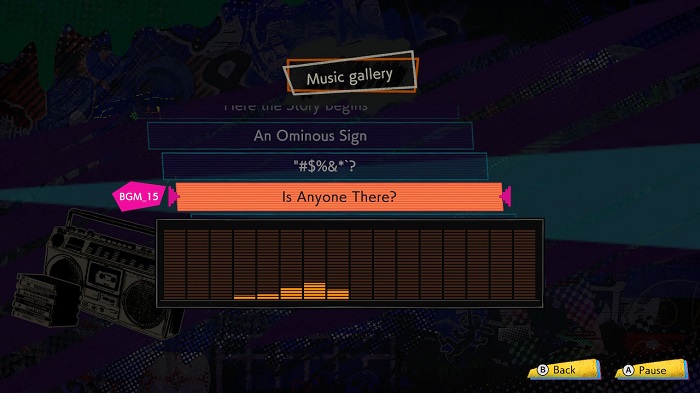
The game is also fully-voice acted during dialogue, with a choice between English and Japanese voices. This will come down to a matter of personal taste. Some will enjoy playing the game with English voices, while others will prefer the original Japanese. In comparing the delivery of lines between both language options, it is worth noting that the inflection of the English voice cast misses the mark at times, as they put the wrong emphasis on certain words. This shows a lack of proper direction while recording their parts. Overall though, the voices of both casts match the characters well enough.
REPLAY VALUE
Replaying stages that require you to make a decision is necessary in order to see the game’s true ending. Otherwise, you won’t be able to see World’s End Club‘s plot resolved in a satisfying manner. Going through previous stages may also be necessary if you happen to miss some of the game’s collectible items: stickers. These are spread out over the game’s platforming levels, and serve to provide a fun resource to collect as you play the game. You can view each sticker you collect in the Sticker Book section of the pause menu. Each sticker depicts the heroes and villains from the game’s fictional Electro Rangers television show. They serve no useful purpose, but they’re cute little collectibles.
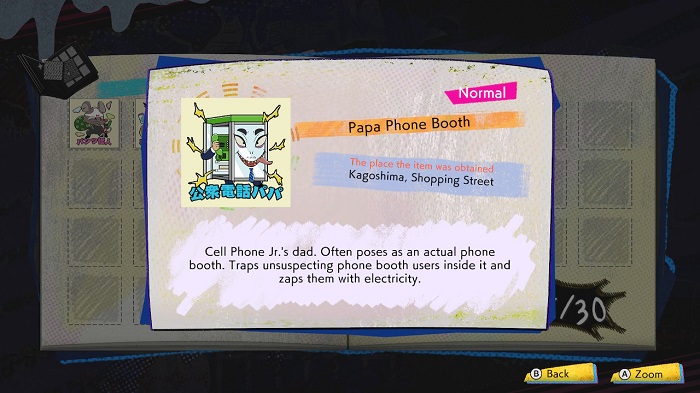
CONCLUSION
Whether you like World’s End Club or not will depend on how reasonable your expectations are going into playing it. If you assume it will be about a death game because some of the developers worked on games like that in the past, you may not like it. However, if you’re open to playing something new from writers you know can craft a great story, you are likely to be pleasantly surprised at how they’ve made a cheerful and optimistic game for a change, while maintaining that same quality in plot. Just know that the saccharine sweetness of some scenes can be a bit too much if you’re an overly serious person, and that the platforming will not be challenging even for the most novice fans of the genre. In fact, the game might be a particularly good fit for younger gamers, especially preteens given the age of the characters and the slightly serious tones the game has at times. That doesn’t mean people of all ages can’t enjoy the game though, since the story is particularly interesting and the characters are memorable. If you’re a fan of post-apocalyptic tales and adventure, World’s End Club is a great journey to take alongside the Go-Getters Club.
Final Rating: 7.5/10.

